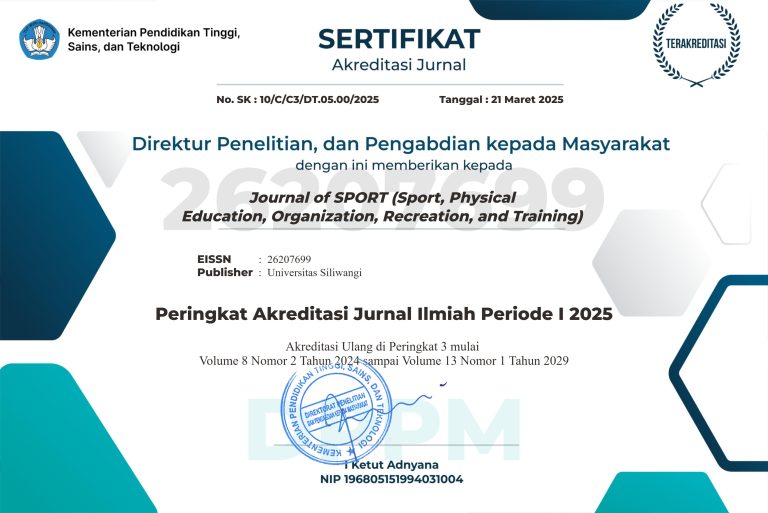Pengembangan Latihan Kebugaran HIIT 7 Menit Berbasis Aplikasi Android
Abstrak
Kata Kunci
Teks Lengkap:
PDFReferensi
AnywhereSoftware. (2021). B4x Getting Started. Anywhere Software. retrieved from https://www.b4x.com/guides/B4XGettingStarted/?page=6
Briand, J., Tremblay, J., & Thibault, G. (2022). Can Popular High-Intensity Interval Training (HIIT) Models Lead to Impossible Training Sessions?. Sports, 10(1), 1-10.
Chen, C., Lu, M., Wu, Y., Zhang, Z., Hu, J., Yin, J., Zhou, W., Xu, J.-Y., Lv, H., & Qin, L.-Q. (2022). The prevalence of hypertension and elevated blood pressure and its correlation with overweight/obesity among students aged 6–17 years in Suzhou. Journal of Pediatric Endocrinology and Metabolism, 35(3), 341–348.
Datareportal. (2022). Digital 2022 Indonesia. retrieved from https://datareportal.com/reports/digital-2022-indonesia
Dixit, S., Haladkar, R., Tele, A., Kataria, S., & Chintawar, S. (2022). Android Notes Application. International Research Journal of Modernization in Engineering Technology and Science, 4(3), 2032–2038.
Garber, C. E., Blissmer, B., Deschenes, M. R., Franklin, B. A., Lamonte, M. J., Lee, I. M., Nieman, D. C., Swain, D. P., & American College of Sports Medicine (2011). American College of Sports Medicine position stand. Quantity and quality of exercise for developing and maintaining cardiorespiratory, musculoskeletal, and neuromotor fitness in apparently healthy adults: guidance for prescribing exercise. Medicine and science in sports and exercise, 43(7), 1334–1359. https://doi.org/10.1249/MSS.0b013e318213fefb
Gibala, M. J., & Little, J. P. (2010). Just HIT it! A time-efficient exercise strategy to improve muscle insulin sensitivity. The Journal of physiology, 588(Pt 18), 3341–3342. https://doi.org/10.1113/jphysiol.2010.196303
Gibala, M. J., Little, J. P., Van Essen, M., Wilkin, G. P., Burgomaster, K. A., Safdar, A., Raha, S., & Tarnopolsky, M. A. (2006). Shortâ€term sprint interval versus traditional endurance training: similar initial adaptations in human skeletal muscle and exercise performance. The Journal of Physiology, 575(3), 901–911.
Herlan, H., & Komarudin, K. (2020). Pengaruh metode latihan high-intensity interval training (Tabata) terhadap peningkatan VO2Max pelari jarak jauh. Jurnal Kepelatihan Olahraga, 12(1), 11-17.
João, G. A., Rodriguez, D., Tavares, L. D., Carvas Júnior, N., Pontes Júnior, F. L., Rica, R. L., ... & Figueira Júnior, A. (2022). The effect of high-intensity interval training on post-exercise oxygen consumption: a meta-analysis. Revista Brasileira de Medicina do Esporte, 29
Klika, B., & Jordan, C. (2013). High-intensity circuit training using body weight: Maximum results with minimal investment. ACSM’s Health & Fitness Journal, 17(3), 8–13.
Kumar, D. (2022). An Assessment Of Physical Fitness Among Senior Secondary School Students. Age, 16(18.10), 7–758.
Laforgia, J., Withers, R. T., & Gore, C. J. (2006). Effects of exercise intensity and duration on the excess post-exercise oxygen consumption. Journal of Sports Sciences, 24(12), 1247–1264.
Little, J. P., Safdar, A., Wilkin, G. P., Tarnopolsky, M. A., & Gibala, M. J. (2010). A practical model of lowâ€volume highâ€intensity interval training induces mitochondrial biogenesis in human skeletal muscle: potential mechanisms. The Journal of Physiology, 588(6), 1011–1022.
Mawlood-Yunis, A.-R. (2022). Getting Started with Android. In Android for Java Programmers (pp. 51–93). Springer.
Michailidis, Y., Ganotakis, C., Motsanos, N., & Metaxas, T. (2022). The effects of an HIIT program on young soccer players’ physical performance. International Journal of Sports Science & Coaching, 17479541221102530. https://doi.org/10.1177/17479541221102530
Millah, H., & Priana, A. (2020). Pengembangan Penghitungan Kapasitas Volume Oksigen Maksimal (Vo2max) Menggunakan Tes Lari 2, 4 KM Berbasis Aplikasi Android. Gelanggang Olahraga: Jurnal Pendidikan Jasmani Dan Olahraga, 3(2), 156–169.
Møller, N., Schmitz, O., Pørksen, N., Møller, J., & Jørgensen, J. O. L. (1992). Dose-response studies on the metabolic effects of a growth hormone pulse in humans. Metabolism, 41(2), 172–175.
Moreno, J. E., De León, L. G., Ortiz-RodrÃguez, B., & Candia-Luján, R. (2022). High intensity interval training (HIIT) in an aquatic environment. A systematic review. Science & Sports. https://doi.org/https://doi.org/10.1016/j.scispo.2021.12.004
Muntaner-Mas, A., Martinez-Nicolas, A., Quesada, A., Cadenas-Sanchez, C., & Ortega, F. B. (2021). Smartphone app (2kmFIT-App) for measuring cardiorespiratory fitness: validity and reliability study. JMIR mHealth and uHealth, 9(1), e14864.
Nugraha, A. R., & Berawi, K. N. (2017). Pengaruh high intensity interval training (HIIT) terhadap kebugaran kardiorespirasi. Jurnal Majority, 6(1), 1-5.
Ompi, S. (2022). Pengukuran Kebugaran Jasmani Remaja Di Desa Tumbak Kecamatan Pusomaen Minahasa Tenggara. Abdimas: Jurnal Pengabdian Kepada Masyarakat, 14(3).
Rubiana, I., Indrawan, B., & Malik, A. A. (2022). Development and Validation of UNSIL Basketball Guide (PUBbG) Applications Based on Android. JUARA: Jurnal Olahraga, 7(1), 241-248.
Sabag, A., Little, J. P., & Johnson, N. A. (2022). Lowâ€volume highâ€intensity interval training for cardiometabolic health. The Journal of Physiology, 600(5), 1013–1026.
Şahın, D. Ö., Akleylek, S., & Kiliç, E. (2022). LinRegDroid: Detection of Android malware using multiple linear regression models-based classifiers. IEEE Access, 10, 14246–14259.
Sari, I. P. T. P., Kriswanto, E. S., Sunardi, J., & Andrianto, S. D. (2022). Needs Analysis Development of Android-Based Physical Fitness Guide. Conference on Interdisciplinary Approach in Sports in Conjunction with the 4th Yogyakarta International Seminar on Health, Physical Education, and Sport Science (COIS-YISHPESS 2021), 251–254.
Sari, N. K., & Ayunita, N. (2019). Pengaruh Diet Sehat Bagi Penderita Berat Badan Lebih atau Obesitas pada Remaja.
Scott, C. B., Leighton, B. H., Ahearn, K. J., & McManus, J. J. (2011). Aerobic, anaerobic, and excess postexercise oxygen consumption energy expenditure of muscular endurance and strength: 1-set of bench press to muscular fatigue. The Journal of Strength & Conditioning Research, 25(4), 903–908.
Shiraev, T., & Barclay, G. (2012). Evidence based exercise: Clinical benefits of high intensity interval training. Australian family physician, 41(12), 960-962.
Sugiyono. (2011). Metode Penelitian Kuantitatif, Kualitatif dan R&D. Bandung: Alfabeta.
Sujadi. (2003). Metode Penelitian Pendidikan. Bandung: Rineka Cipta.
Vlachogianni, P., & Tselios, N. (2021). Perceived usability evaluation of educational technology using the System Usability Scale (SUS): A systematic review. Journal of Research on Technology in Education, 1-18.
Vriend, I., Coehoorn, I., & Verhagen, E. (2015). Implementation of an app-based neuromuscular training programme to prevent ankle sprains: a process evaluation using the RE-AIM Framework. British journal of sports medicine, 49(7), 484-488.
Wernbom, M., Augustsson, J., & Thomeé, R. (2007). The influence of frequency, intensity, volume and mode of strength training on whole muscle cross-sectional area in humans. Sports Medicine, 37(3), 225–264.
DOI: https://doi.org/10.37058/sport.v7i2.7807
Refbacks
- Saat ini tidak ada refbacks.
##submission.copyrightStatement##
Journal of SPORT (Sport, Physical Education, Organization, Recreation, and Training)
Program Studi Pendidikan Jasmani
Fakultas Keguruan dan Ilmu Pendidikan
Universitas Siliwangi
Jl. Siliwangi No. 24 Kota Tasikmalaya - 46115
email: penjas@unsil.ac.id
e-ISSN: 2620-7699 ; p-ISSN: 2541-7126

This work is licensed under a Creative Commons Attribution-ShareAlike 4.0 International License.
INDEX BY
1.png)










 Scopus Id:Â
Scopus Id:Â  ORCID:Â
ORCID:Â  Google Scholar:Â
Google Scholar:Â 


